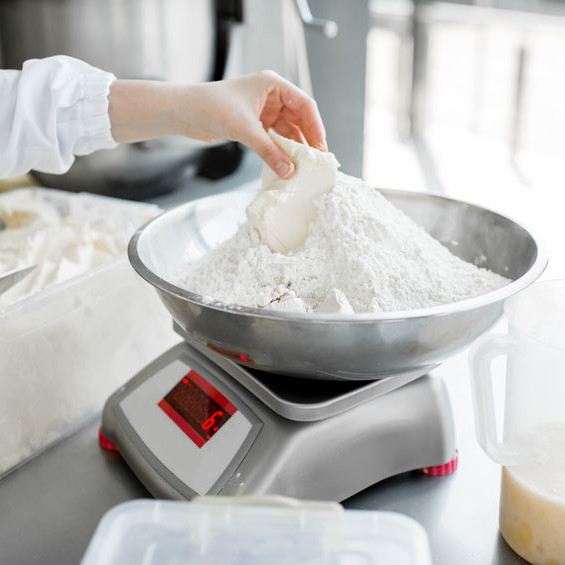
Baker’s Percent
What is Baker’s Percent?
Baker’s percent is a mathematical method widely used in baking to calculate the amounts of macro, minor and micro ingredients. It’s based on the total weight of flour a formula contains. Instead of dividing each ingredient’s weight by the total formula weight, bakers divide each ingredient by the weight of flour. Baker’s percent is useful for quickly assessing if a formula is drier, saltier, sweeter, etc.
Baker’s percent is internationally used to express formulas for bakery products such as pan bread, buns, rolls, cookies, cakes, crackers, doughnuts, etc.
How does baker’s percent work?
In baker’s percent, the weight of the flour is always 100%, and the total percent of all the other ingredients is always greater than 100%. This concept is completely different from the True or Conventional Percent, where the combined ingredients total 100%.
The mathematical equation for obtaining baker’s percent is:

Y: water, yeast, sugar, salt, fat, milk solids, redox agent, emulsifier, etc.
The following table presents a typical example of the baker’s % concept:
| Ingredient | Weight (Lb) | Baker’s % | True % |
| Flour | 60.0 | 100.0 | 56.818 |
| Water | 37.2 | 62.0 | 35.227 |
| Yeast | 1.8 | 3.0 | 1.705 |
| Salt | 1.2 | 2.0 | 1.136 |
| Sugar | 2.4 | 4.0 | 2.273 |
| Shortening | 1.8 | 3.0 | 1.705 |
| Defatted milk solids | 1.2 | 2.0 | 1.136 |
| Total | 105.6 | 176.0 | 100.0 |
The greatest benefit to using baker’s percent is that the baker can change the amount of any ingredient at any time, without the need to refigure the percents of all other ingredients. This is very useful when formulating new products, adjusting processing parameters, and customizing old recipes to fit modern dietary guidelines.
From the baker’s percent equation and table, bakers have the possibility of making any quantity of product or a desired batch weight. The following steps are needed:
- Add total baker’s percent.
- Divide the desired or total batch weight by the total baker’s percent (in decimal form). This gives the weight of flour.
- Multiply the baker’s percent of each ingredient (in decimal form) times the weight of flour. This gives the weight of each ingredient needed to make the desired batch.
Application
Baker’s percentage makes it easy to see at a glance the ingredient ratios and, therefore, the basic structure and composition of the dough or batter that will be obtained after mixing.1
By using baker’s percent, a baker can predict crumb structure from the dough water content or hydration. For example, 80% hydration (8 parts water to 10 parts flour) often leads to an airy and irregular crumb such as in Italian Ciabatta bread while 60% hydration (6 parts water to 10 parts flour) yields denser and closed crumb similar to American-style bread. More accurate predictions can be made when hydration numbers are combined with information on type of flour used.
There are many advantages to using baker’s percent as opposed to other forms of measurement. Baker’s percent leads to greater consistency in recipes because it is always based on weight (pounds or kilograms). Advantages of applying the baker’s percent approach include:2
- Ease and simplicity of scaling up or down formulas to meet higher or lower demands
- Consistency of results
- Quickness to correct defects in the formula (it is easier to tell if one recipe is drier, sweeter or saltier than another recipe)
- Ability to check if a formula is well-balanced
- Precision of measurement and eliminating/fixing scale errors
- Common language among bakers when comparing formulas
- Consistency in production
- Ease of calculating the water absorption or hydration of the flour
- Ease in predicting how the final product will look like
Special considerations
- Scaling/metering equipment used in automated production lines can be designed and configured to work with set points based on baker’s % or true %. The chosen method in this case could be a function of precise control on the exact water absorption value of flour, as other ingredients (e.g., sweetener syrups, molasses, cream yeast, eggs) also contribute with some water to the final dough.
- When multiple flours such as whole wheat, rye, cornmeal, or wheat patent are used in a formula as in the case of multigrain and high-fiber breads, the total weight of all flour- and grain-type ingredients is usually assigned to be 100%. All other ingredients in the formula are calculated as a percentage of the total of these ingredients.3,4
References
- Gisslen, W. “Basic Professional Skills: Bakeshop Math and Food Safety” Professional Baking, 7th edition, John Wiley & Sons, Inc., Hoboken, New Jersey, 2017, pp. 15–25.
- Suas, M. “Appendix B: Baker’s Percentages” Advanced Bread and Pastry: A Professional Approach, first printing, Delmar, Cengage Learning, 2009, pp. 995–999.
- Labensky, S.R. “Artisan and Yeast Breads” On Baking: A Textbook of Baking and Pastry Fundamentals, 3rd edition, Pearson Education, Inc., 2016, pp. 189–192.
- Gisslen, W. “Rich Yeast Doughs” Professional Baking, 7th edition, John Wiley & Sons, Inc., Hoboken, New Jersey, 2017, pp. 222–223.

